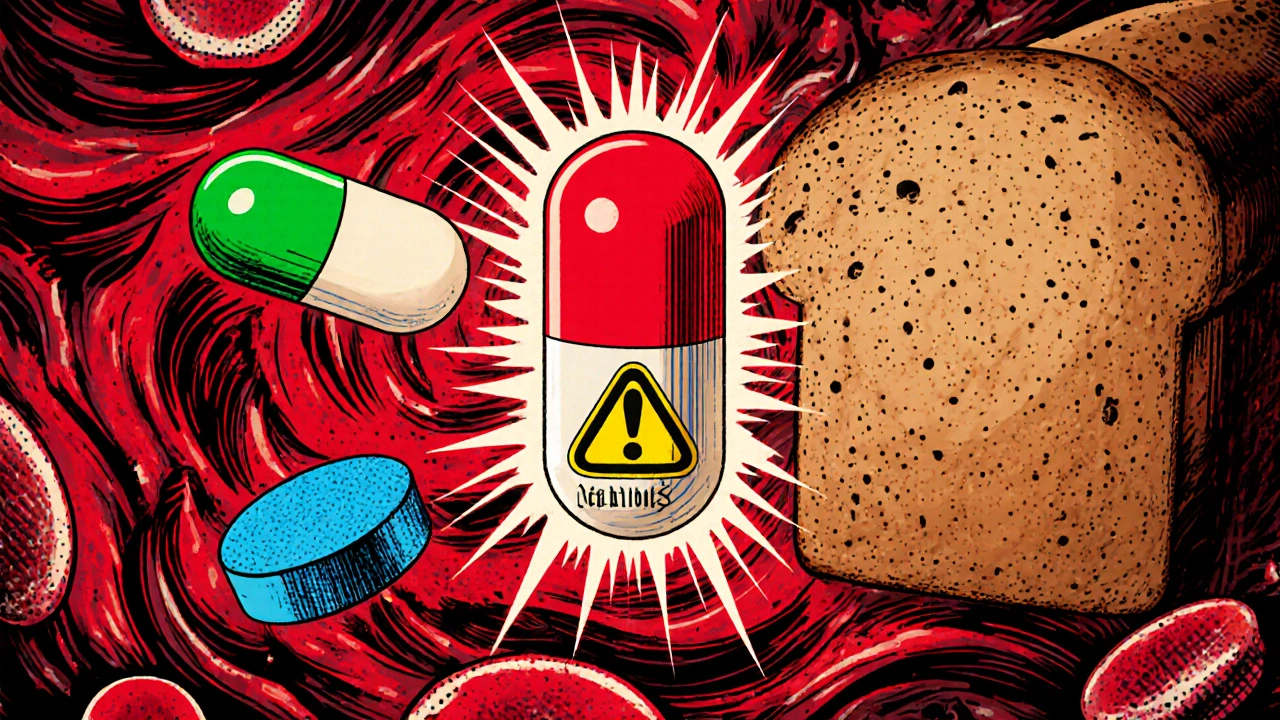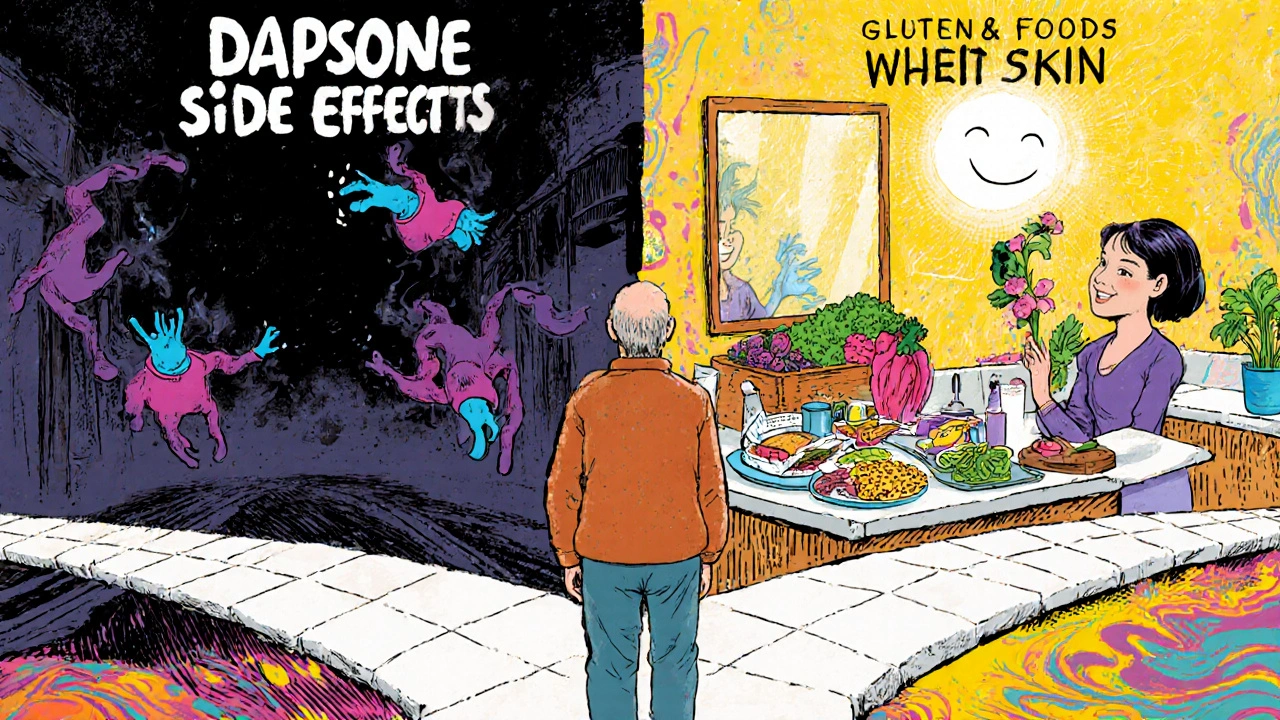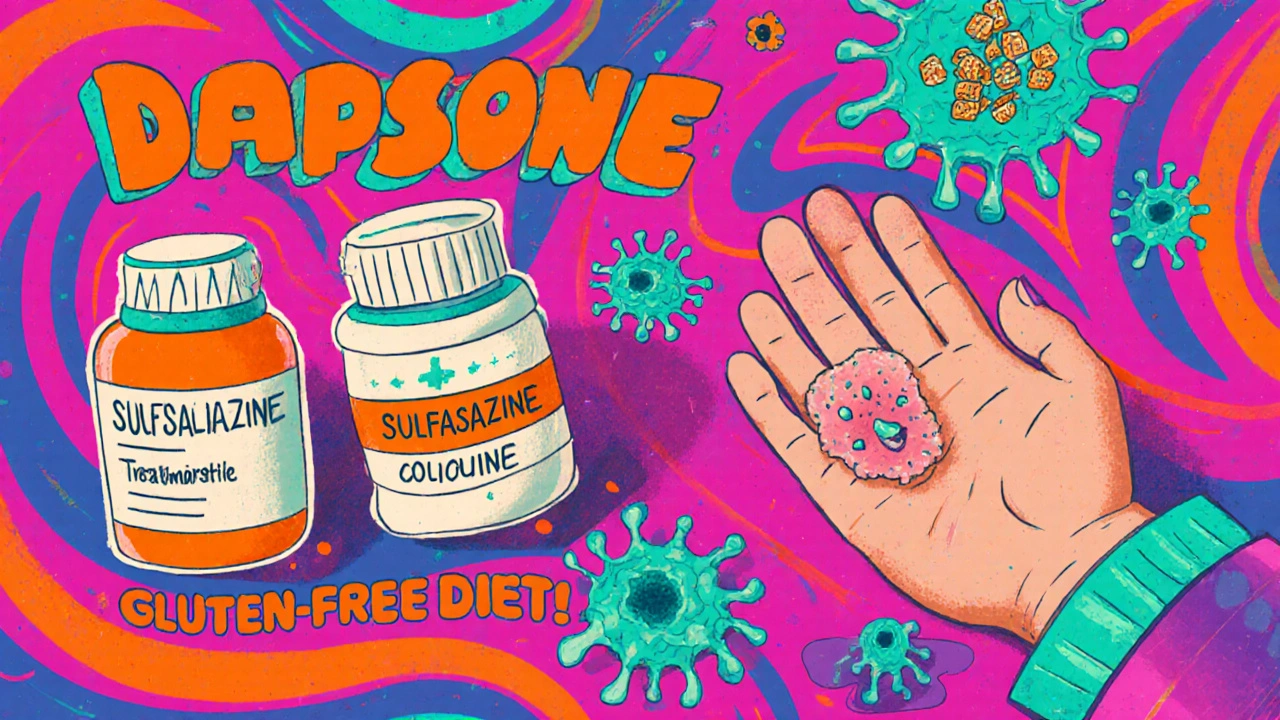Dapsone isn’t a drug most people know by name, but if you’ve been diagnosed with dermatitis herpetiformis, leprosy, or certain types of chronic hives, it might be your go-to treatment. It’s been around since the 1940s, works differently than most antibiotics, and has a reputation for being effective-but not without side effects. Many patients end up asking: Are there better or safer options? The answer isn’t simple. Some alternatives work just as well. Others are cheaper. A few are easier on your body. Let’s break down what Dapsone does, who it helps, and what else you can try.
What Dapsone Actually Does
Dapsone is an antibiotic, but it doesn’t work like penicillin or amoxicillin. Instead, it blocks folate synthesis in bacteria and certain immune cells. This makes it useful for two very different problems: killing the bacteria that cause leprosy (Mycobacterium leprae) and calming the immune overreaction behind skin conditions like dermatitis herpetiformis.
For dermatitis herpetiformis-the itchy, blistering skin condition linked to celiac disease-Dapsone often clears up symptoms in days. It doesn’t fix the gluten intolerance, but it silences the skin reaction. For leprosy, it’s part of a combo therapy, usually with rifampicin and clofazimine, to prevent drug resistance.
It’s taken orally, usually once a day. Most people start with 50-100 mg daily. The dose can be lowered over time if symptoms improve. But here’s the catch: Dapsone can cause serious side effects, especially in people with certain genetic traits or pre-existing conditions.
Common Side Effects of Dapsone
Not everyone has problems, but enough do that you need to know the risks:
- Heinz body anemia-a type of red blood cell damage that can cause fatigue, shortness of breath, and pale skin. This is more common in people with G6PD deficiency.
- Methemoglobinemia-when too much oxygen gets stuck in your blood cells. You might notice bluish lips or fingernails, dizziness, or confusion.
- Peripheral neuropathy-tingling, numbness, or burning in hands and feet, especially with long-term use.
- Liver toxicity-elevated liver enzymes, sometimes leading to jaundice.
- Severe skin reactions-like Stevens-Johnson syndrome, though rare.
Because of these risks, doctors usually order a blood test before starting Dapsone-especially to check for G6PD deficiency. If you’re of African, Mediterranean, or Southeast Asian descent, this test is critical. You can’t safely take Dapsone if you’re deficient.
Alternative 1: Sulfasalazine for Dermatitis Herpetiformis
If you’re taking Dapsone for skin blisters and itching due to celiac disease, sulfasalazine is the most common alternative. It’s also a sulfa drug, so it works similarly by reducing inflammation in the skin. Studies show it’s about as effective as Dapsone for controlling dermatitis herpetiformis symptoms.
Advantages:
- Lower risk of methemoglobinemia and hemolytic anemia
- Less likely to cause nerve damage
- Often cheaper than Dapsone
Disadvantages:
- Can cause nausea, headaches, and dizziness
- May cause temporary male infertility (reversible when stopped)
- Slower to work-takes weeks instead of days
- Not safe if you’re allergic to sulfa drugs
Most patients who switch from Dapsone to sulfasalazine do so because of side effects, not lack of effectiveness. If you can tolerate the slower start, sulfasalazine is a solid backup.
Alternative 2: Colchicine for Chronic Hives and Inflammation
Colchicine is best known for treating gout, but it’s also used off-label for chronic urticaria (hives) and other inflammatory skin conditions. It works by blocking immune cells that trigger swelling and itching.
Why consider it?
- No risk of methemoglobinemia
- Doesn’t affect red blood cells like Dapsone
- Works well for patients who can’t take sulfa drugs
But it’s not perfect:
- Can cause diarrhea, vomiting, or abdominal pain
- Dosage must be carefully controlled-too much can be toxic
- Less studied for dermatitis herpetiformis than Dapsone or sulfasalazine
It’s often used when patients fail both Dapsone and sulfasalazine. Some dermatologists start with colchicine if a patient has a history of blood disorders or G6PD deficiency.

Alternative 3: Rituximab for Severe or Refractory Cases
If you’ve tried Dapsone, sulfasalazine, and colchicine-and nothing worked-you might be a candidate for biologics like rituximab. This is a powerful IV drug that targets B-cells, the immune cells that produce the antibodies attacking your skin.
Rituximab is approved for rheumatoid arthritis and some cancers, but it’s used off-label for severe, treatment-resistant dermatitis herpetiformis. A 2023 study in the Journal of the American Academy of Dermatology showed 87% of patients had complete skin clearance after 3-6 months of treatment.
But here’s the reality:
- Cost: Around $10,000 per infusion
- Requires hospital visits
- Increases infection risk
- Not first-line-only after other options fail
This isn’t a replacement for Dapsone. It’s a last-resort tool for the small group of people who don’t respond to anything else.
Alternative 4: Gluten-Free Diet (The Real Fix)
Here’s something most people don’t realize: Dapsone doesn’t cure dermatitis herpetiformis. It only masks the symptoms. The real problem? Gluten.
Dermatitis herpetiformis is the skin version of celiac disease. If you stop eating gluten, your immune system stops attacking your skin. Many patients see their rashes fade within weeks-even without medication.
Studies show that after 1-2 years on a strict gluten-free diet, up to 70% of patients can stop taking Dapsone entirely. The skin stays clear. Blood tests normalize. Liver function improves.
But here’s the catch: going gluten-free isn’t easy. You have to avoid wheat, barley, rye, and hidden sources like soy sauce, malt vinegar, and some medications. Cross-contamination in kitchens or restaurants can trigger flares.
That’s why many doctors still prescribe Dapsone: it gives fast relief while patients adjust. But if you’re serious about long-term health, the diet is the only cure.
What About Other Antibiotics?
Some patients ask: Can I use doxycycline, minocycline, or tetracycline instead?
These antibiotics are sometimes used for acne or rosacea, but they don’t work the same way as Dapsone. They don’t target the immune-driven blistering in dermatitis herpetiformis. For leprosy, they’re not effective enough on their own.
There’s one exception: clofazimine. It’s used with Dapsone in leprosy treatment, but it’s not a standalone alternative. It causes skin discoloration (turning skin reddish-brown), which many patients find unacceptable.
Bottom line: don’t swap Dapsone for random antibiotics. They won’t do the same job.

Choosing the Right Alternative for You
There’s no single best alternative. The right choice depends on your health history, budget, and how you respond to side effects.
Here’s a quick decision guide:
| Drug | Best For | Speed of Relief | Major Risks | Cost (Monthly) |
|---|---|---|---|---|
| Dapsone | Fast symptom control for DH or leprosy | Days | Anemia, methemoglobinemia, nerve damage | $30-$80 |
| Sulfasalazine | Long-term DH control, sulfa-tolerant patients | Weeks | Nausea, headache, temporary infertility | $20-$50 |
| Colchicine | Patients with G6PD deficiency or blood disorders | Weeks | Diarrhea, toxicity at high doses | $40-$100 |
| Rituximab | Severe, treatment-resistant cases | Months | Infection risk, high cost, IV only | $8,000-$12,000 |
| Gluten-free diet | Root cause solution for DH | Weeks to months | Difficult to maintain, social challenges | $0-$200 (food costs) |
If you have G6PD deficiency, skip Dapsone and sulfasalazine. Start with colchicine and diet. If cost is a barrier, sulfasalazine is your best bet. If you need fast relief and have no blood issues, Dapsone still has value. And if you’re ready to commit to lifestyle change, the gluten-free diet is the only path to true freedom from medication.
What to Do Next
If you’re on Dapsone and thinking about switching:
- Ask your doctor for a G6PD blood test if you haven’t had one.
- Get your liver enzymes and complete blood count checked-especially if you’ve been on Dapsone for more than 3 months.
- Ask about trying sulfasalazine or colchicine as a replacement.
- Work with a dietitian to start a gluten-free diet-even if you’re not sure you have celiac disease. Many people with dermatitis herpetiformis test negative for celiac antibodies but still respond to gluten elimination.
- Don’t stop Dapsone suddenly. Your symptoms could flare badly. Taper under medical supervision.
If you’re newly diagnosed, don’t rush into medication. Get tested for celiac disease first. If you have it, the diet isn’t just an option-it’s the treatment.
Frequently Asked Questions
Can I take Dapsone if I’m allergic to sulfa drugs?
No. Dapsone is a sulfone drug, chemically similar to sulfa antibiotics. If you’ve had a rash, swelling, or breathing trouble from sulfa drugs like Bactrim or sulfasalazine, you should avoid Dapsone. Talk to your doctor about colchicine or rituximab instead.
How long does it take for Dapsone to work for skin rashes?
Most people see improvement in itching and blisters within 2 to 7 days. Full clearance often takes 2 to 4 weeks. If there’s no change after 4 weeks, your doctor should consider switching treatments.
Is Dapsone safe during pregnancy?
Dapsone is classified as Pregnancy Category C. Animal studies showed harm, but human data is limited. It’s usually avoided unless the benefits clearly outweigh the risks. If you’re pregnant and need treatment for dermatitis herpetiformis, a strict gluten-free diet is the safest first step. Sulfasalazine is often preferred over Dapsone during pregnancy.
Can Dapsone cause weight gain?
Weight gain isn’t a common side effect of Dapsone. Some patients report fluid retention or increased appetite, but these are rare. If you’re gaining weight while on Dapsone, it’s more likely due to other factors-like improved health from reduced inflammation or changes in diet.
What happens if I stop Dapsone cold turkey?
Stopping suddenly can cause your skin condition to flare worse than before. You might develop new blisters, intense itching, or even systemic symptoms like fever. Always taper the dose slowly under your doctor’s guidance-usually by reducing by 25% every 2 to 4 weeks.
Are there natural alternatives to Dapsone?
There are no proven natural alternatives that match Dapsone’s effectiveness for dermatitis herpetiformis or leprosy. Some people try turmeric, omega-3s, or probiotics to reduce inflammation, but these won’t stop the immune attack causing the blisters. The only natural approach with real evidence is a strict gluten-free diet-for those with celiac-linked skin disease.
Final Thoughts
Dapsone isn’t going away. It’s still the fastest, most reliable option for certain skin and infectious diseases. But it’s not the only option-and for many, it’s not the best long-term choice. Side effects, cost, and the availability of safer alternatives mean you should never just accept it as your only path.
The real win? Combining medication with lifestyle change. For dermatitis herpetiformis, a gluten-free diet doesn’t just reduce symptoms-it can eliminate the need for drugs entirely. For leprosy, Dapsone remains essential, but early diagnosis and full combo therapy prevent disability.
Ask questions. Get tested. Know your options. Your skin-and your body-will thank you.

Jules Tompkins
October 28, 2025 AT 02:38Been on dapsone for 8 months for DH. My lips turned blue once. Felt like I was dying. Never again. Switched to sulfasalazine and my skin’s been calm for 6 months. No drama. Just a little nausea at first. Worth it.
j jon
October 28, 2025 AT 18:35Gluten-free diet is the real MVP. No meds, no side effects. Just hard as hell to stick to. But if you do it right? Your skin clears. Your gut heals. You stop feeling like a walking allergy.
Kathryn Conant
October 29, 2025 AT 20:27Colchicine is underrated. I was terrified of dapsone after reading about methemoglobinemia. My doc pushed colchicine and I was skeptical. Two weeks in? The itching stopped. Three weeks? No blisters. I’m not saying it’s perfect-my stomach hates it-but it’s a damn sight better than risking my blood turning to sludge.
Kimberly Ford
October 30, 2025 AT 15:11For anyone considering switching: get your G6PD test done before you even think about dapsone. I didn’t. Ended up in the ER with hemolytic anemia. My doctor was furious. Don’t be me. Get tested. It’s a simple blood draw. It could save your life. And yes, the gluten-free diet works-but it’s not a quick fix. It’s a lifestyle. And if you’re serious, find a dietitian who gets celiac disease. Not just any nutritionist. One who knows the difference between cross-contamination and ‘kinda gluten-free.’
Sabrina Bergas
November 1, 2025 AT 04:33Y’all are acting like dapsone is the devil. It’s a 1940s drug, sure, but it’s still the gold standard for DH. Rituximab? $10k per infusion? That’s not medicine, that’s a luxury spa for your immune system. And gluten-free diet? Sure, it works. But most people can’t maintain it. They cheat, they get a flare, they blame themselves. Meanwhile, dapsone gives you back your life. Just monitor your blood. Simple.
jennifer sizemore
November 2, 2025 AT 23:13I switched from dapsone to sulfasalazine after my doctor said I had borderline G6PD deficiency. Took 3 weeks to feel better, but now I’m off meds entirely. I started the gluten-free diet and honestly? I feel better than I have in 10 years. No more brain fog. No more random rashes. And I didn’t even realize how much my joints hurt until it went away. Also, gluten-free bread is way better now. Who knew?
Melvin Thoede
November 3, 2025 AT 10:45Just want to say-this post saved me. I was about to refuse dapsone because I read horror stories online. Then I saw the comparison chart. Realized I didn’t need to be scared, I needed to be informed. Got tested, switched to colchicine, and started eating clean. No more blisters. No more panic. Just peace. Thank you for the clarity.
Vishnupriya Srivastava
November 3, 2025 AT 20:14Let’s be real-dapsone is toxic. The fact that it’s still first-line in the US is a reflection of pharmaceutical inertia, not medical superiority. In India, we use dapsone only in leprosy under strict supervision. For DH, we go straight to diet + antihistamines. Why? Because we don’t have the luxury of ignoring side effects. Your system is broken if you need a 1940s antibiotic to manage a dietary trigger. Fix the root cause. Not the symptom.
Rachel Marco-Havens
November 4, 2025 AT 19:54Someone said gluten-free diet is the only cure. That’s true. But most people don’t have the discipline. They want a pill. They want a quick fix. They don’t want to give up bread. So they take dapsone. And then they complain about the side effects. You can’t have it both ways. If you want to be healthy, you have to change. Not just your meds. Your life. Stop blaming the drug. Start blaming yourself for not being willing to do the work.